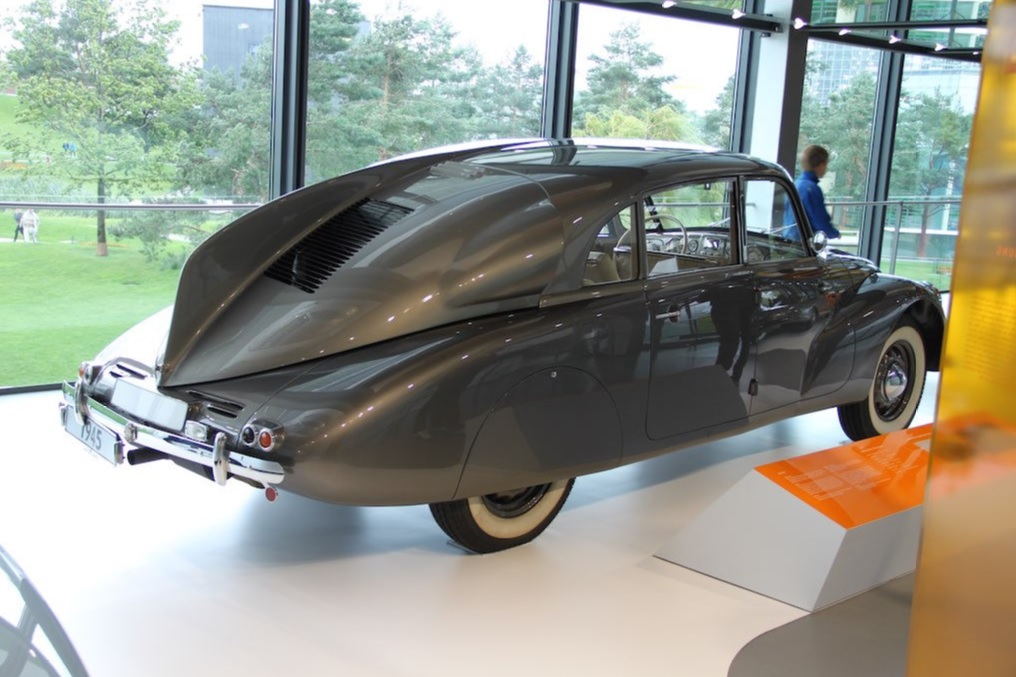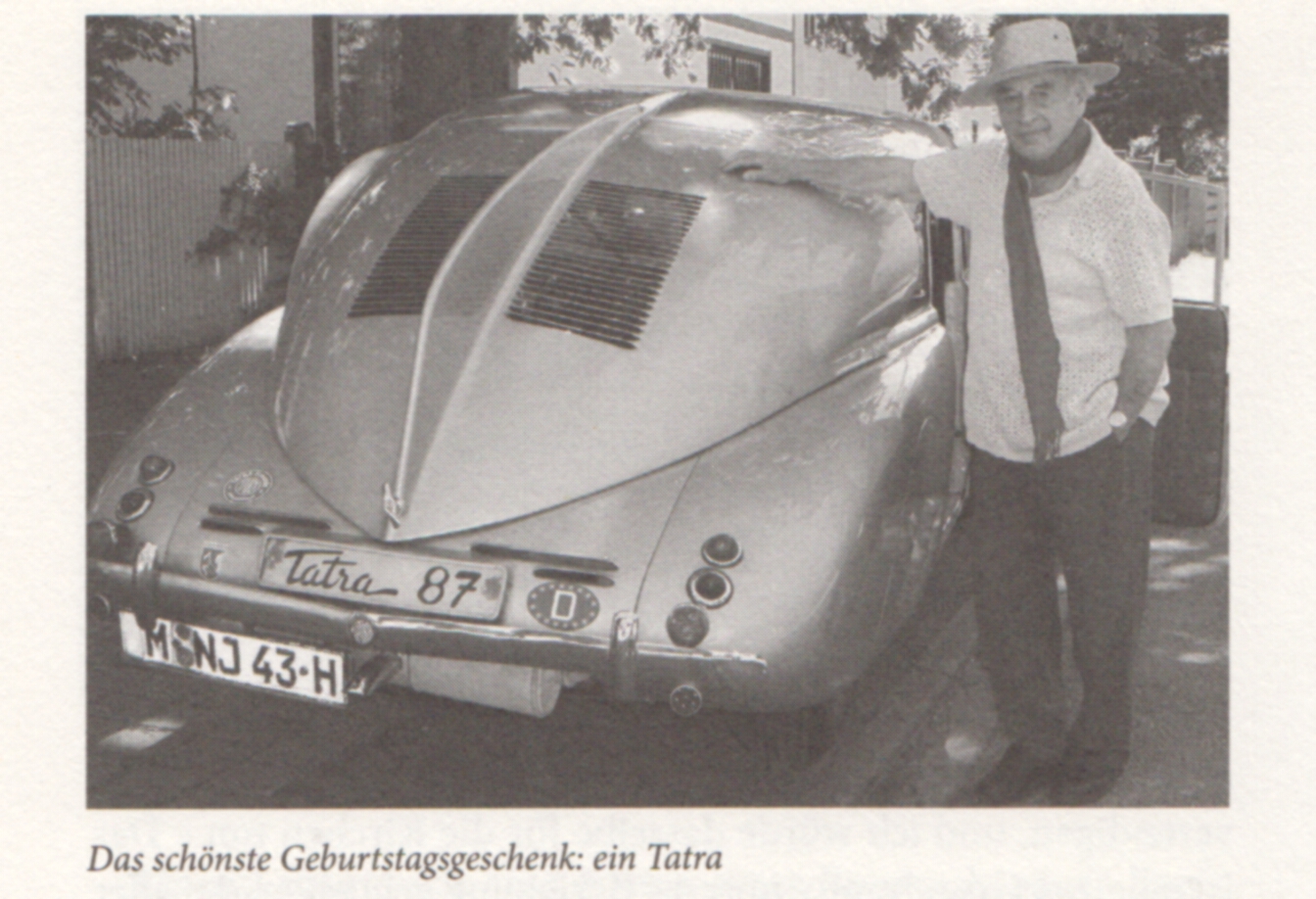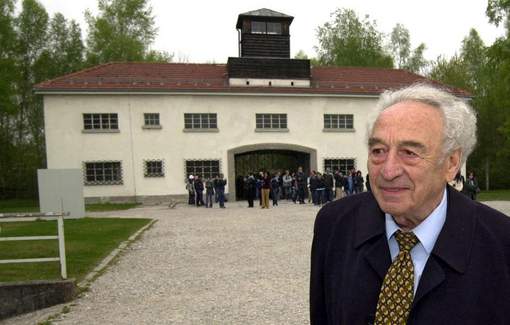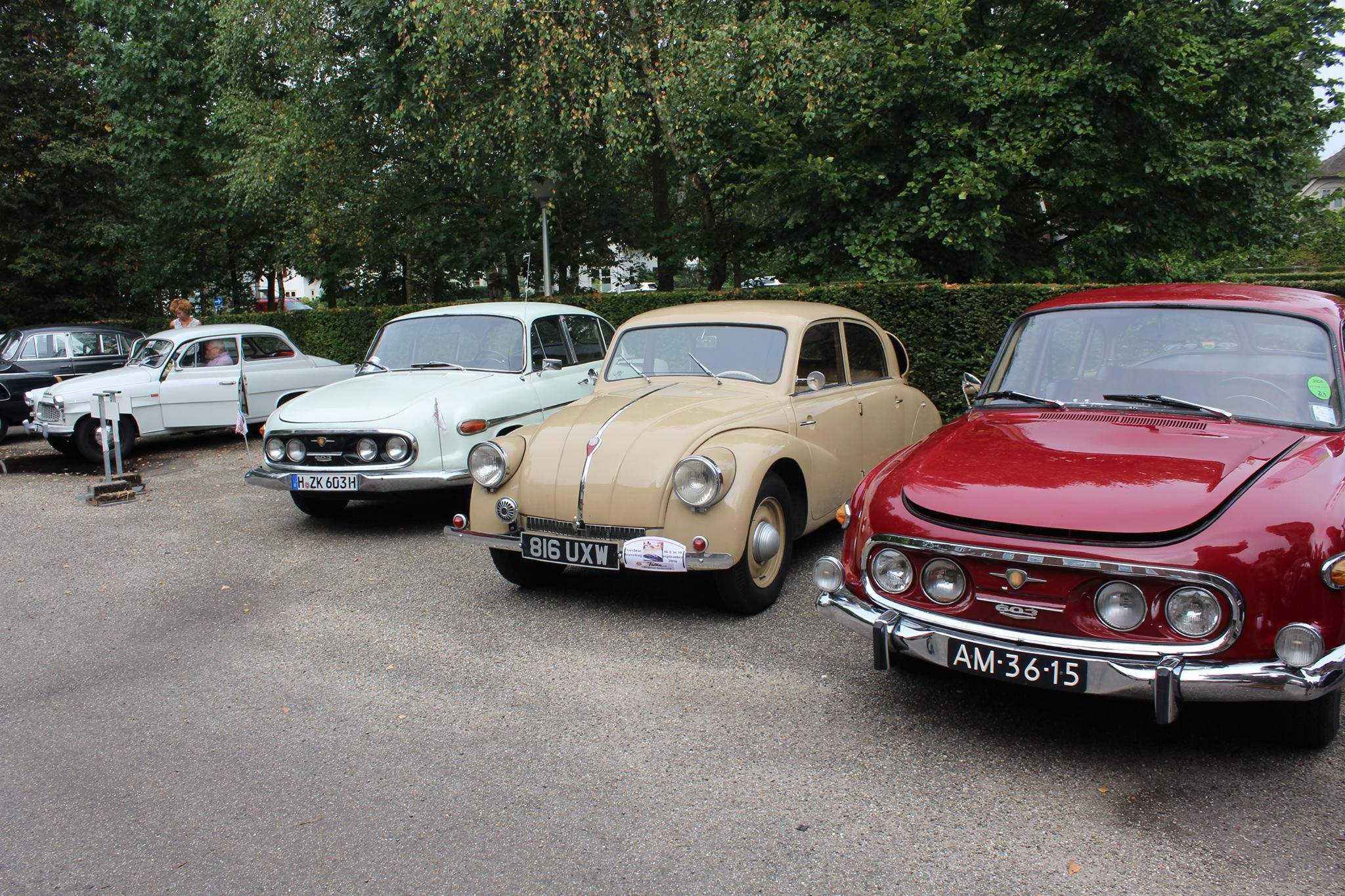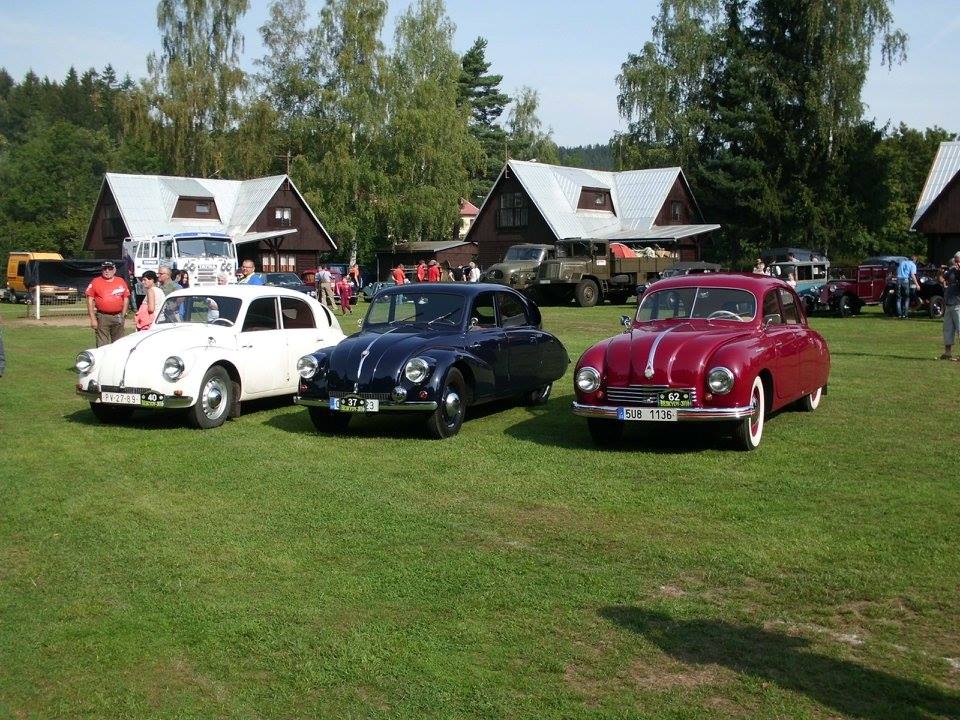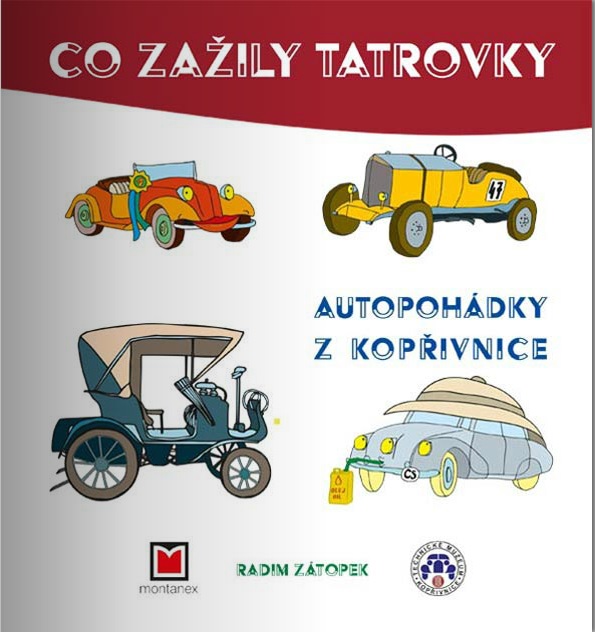Here is a fine photo of Max Mannheimer and his T 87, shot by Ondrej Ertl at the Beskydy Rally of 2001.
Max Mannheimer and his T 87
The Autostadt T 87
How Max Mannheimer got his T 87
On my seventieth birthday in 1990, my brother Edi fulfilled a secret life-long dream. He gave me a vintage car from 1938, a Czech Tatra in silver, which had converted from a wreck into a high-level car in a month-long restoration: three-liter engine, air cooling, oil circulating pump, 75 hp, top speed 160 kph, Rubens inspired curved wings. As a 15-year-old I had seen such a car on the Novy Jicin (Neu-titschein) city square. He belonged to the hat-maker Hückel, cost as many as five Volkswagens, and attracted many admirers, including my brothers and myself. Since then, I had dreamed of driving such a car once. At that time the car was regarded as extremely avant-garde – 55 years later it was still. It had only one construction fault: because of the all-too-big wheels and the long tail fins, it reacted very sensitively to sidewind. Only one thing helped: slowing down. It also had some quirks because of his age. But I also have quirks. So we matched together wonderfully.
I was indefinitely grateful to my brother. He could not have given me a bigger gift. The trips I took on the red leather driving seat, are among my best memories.
(Von der Leyen, Marie-Luise: Max Mannheimer. Drei Leben. S 209-210, München 2012.)
Zu meinem siebzigsten Geburtstag im Jahre 1990 erfüllte mir mein Bruder Edi einen heimlichen Lebenstraum. Er schenkte mir einen Oldtimer von 1938, ein tschechischer Tatra in Silber, der sich in Monatelanger Restaurierung von einem Wrack in ein Hochelegantes Auto verwandelt hatte: drei-Liter Motor, Luftkühlung, Öl-Umlaufpumpe, 75 PS, Spitzengeschwindigkeit 160 km/h, rubensartig gewölbte Kotflügel. Als 15-Jähriger hatte ich auf dem Neutitscheiner Stadtplatz einen solchen Wagen gesehen. Er hatte dem Hutfabrikanten Hückel gehört, so viel wie fünf Volkswagen gekostet und viele Leute herbeigelockt, die ihn bestaunten, auch meine Brüder und mich. Seither hatte ich davon geträumt, einmal einen solchen Wagen zu fahren. Seinerzeit galt er als ungeheuer avantgardistisch – 55 Jahre später war er es noch immer. Er hatte nur einen Konstruktionsfehler: Wegen der allzu grossen Räder und der lange Heckflossen reagierte er sehr empfindlich auf Seitenwind. Da half nur eines: langsamer fahren. Auch sonst hatte er wegen seines Alters einige Macken. Aber Macken habe ich auch. Insofern passten wir wunderbar zusammen.
Ich war meinem Bruder unendlich dankbar. Ein grösseres Geschenk hätte er mir nicht machen können. Die Fahrten, die ich auf dem Roten Ledersitz hinter dem Steuer unternommen habe, gehören zu meinem schönsten Erinnerungen.
(Von der Leyen, Marie-Luise: Max Mannheimer. Drei Leben. S 209-210, München 2012.)
T 87 owner and Holocaust survivor Max Mannheimer (96) has passed away
Max Mannheimer (6 February 1920 Novy Jicin- September 2016 Munich) has passed away in a Munich hospital. He was an author, painter and survivor of the Holocaust. Except for one brother, he lost his entire family in the Holocaust, including his new wife. For decades, he did not speak about his experiences, despite nightmares and depression. In 1986, while traveling in the United States, he happened to see a swastika and the sight of it triggered a nervous breakdown. After that, he began to speak about his experiences at the hand of Nazis, giving talks to young people and adults, at school and universities. He travelled to his lectures with his RHD T 87 as a symbol of the democratic pre-war Czechoslovakia.Mannheimer has won many honors and awards for his work.
May he rest in peace.
Tatraworld profile in English: http://www.tatraworld.nl/2010/04/02/max-mannheimer-a-man-with-a-mission/
Wikipedia profile in English: https://en.wikipedia.org/wiki/Max_Mannheimer
Article in German: http://www.zeit.de/1995/05/Noch_Fragen_bitte_/komplettansicht
Video: T 87 by Classic Car TV (D)
The celebration of 80 years T 87 has been kicked off by the German Classic Car TV. They are a little bit early though as is production started in 1937-1938 with two development cars built in 1936 and five prototypes in 1937.
http://www.classic-car.tv/news/80-jahre-tatra-t87/
Tatra: forerunner of the Beetle?

The roots of the Tatra car go back to 1850 and the Austro-Hungarian Empire when Ignatz Schustala opened a wagon and carriage shop in the Moravian town of Nesselsdorf in the Kingdom of Bohemia.
Ignatz Shustala & Co. established a good reputation but had limited finances to expand until it found backing from wealthy industrialist Adolf Raschaka.
Raschaka unfortunately died in 1877 causing Shustala to flounder until 1881 when financing came from a railway company. Shustala then began manufacturing rolling stock.
When Ignatz Shustla died in 1891 management fell to the company’s technical director, engineer Hugo Fischer von Roslerstamm who became interested in the emerging motor car.
They bought a Benz and engine for evaluation and by 1897 the company, now Nesselsdorfer Wagenbau-Fabriks-Gesellschaft, built its first car.
At this time a brilliant young engineer named Hans Ledwinka joined the company’s railway division. He soon moved to the automotive project where he helped design the first Nesselsdorf car, called the President. Ledwinka would ultimately have a greater influence on Nesselsdorfer, later renamed Tatra, than any other person.
Ledwinka left Nesselsdorfer to help design a steam car but was lured back. He led the company in building a series of successful cars and trucks before and during the First World War.
When promised funding for a new factory was withdrawn, a disillusioned Ledwinka left in 1916 and joined Austrian gun manufacturer Styr who were starting a car division.
After the First World War Nesselsdorfer found itself in the newly formed nation of Czechoslovakia. The company re-named Tatra after Czechoslovakia’s highest mountain range needed engineering talent and Ledwinka returned from Steyr in 1921 to become chief engineer/technical director. It began his most significant period with Tatra.
In the 1920s Ledwinka and Austrian-born engineer, Ferdinand Porsche both recognized that Europe needed a light, sturdy, economical and affordable car like the American Ford Model T. Both were gifted engineers, although Porsche would gain the more lasting legacy with his Volkswagen and Porsche.
Ledwinka’s concept emerged in the technically advanced 1923 Type 11 model. Its flat-twin, air cooled, 1.0 litre front-mounted engine drove the rear wheels. Its most outstanding feature was a tube-type backbone chassis to which were attached the gearbox and four swing axles.
The suspension was a masterpiece of simplicity with single transverse leaf springs forming the upper control arms and shackled directly to the brake backing plates. The Type 11 distinguished itself in competition.
Several models flowed from the talented Ledwinka, and he began envisaging a rear mounted engine for weight and space saving. After experiments in 1931 and ’33 with smaller rear engine cars, his 1934 Type 77 Tatra appeared. It was aerodynamically efficient had four wheel independent suspension, a 3,119 mm (122.8 in.) wheelbase and a 3.0 litre, air cooled, overhead valve, alloy V8 engine behind the rear axle.
The Type 77’s layout was similar to the Volkswagen’s and many Ledwinka ideas such as rear mounted, air cooled engine, backbone chassis and four-wheel independent suspension (although using torsion bars, not leaf springs) would appear in the Volkswagen then under development.
This led to later legal battles over patent infringement that finally concluded in 1967 with Volkswagen paying Tatra an out-of-court settlement of three million marks for what were considered violation of some Tatra patents.
The Type 77 was soon followed by more powerful Type 87 and 97 models with rear mounted, air cooled, overhead cam V8s. Teardrop-shaped, aerodynamic bodies severely reduced rear vision through the engine cooling louvres in the dorsal finned deck lid. Type 87 was built until 1950.
Unfortunately, swing axles and an ‘outboard’ rear engine contributed to instability. What Porsche’s small, low powered Volkswagen could tolerate was exaggerated in Ledwinka’s larger more powerful Tatra. During the Second World War it was said that German officers occupying Czechoslovakia crashed so many Tatras an order was issued forbidding the officers from driving them.
Following the war Czechoslovakia found itself in the East Bloc where Tata was nationalized. Ledwinka was jailed by the Soviets for his unwilling role as war-time manager of defence programs.
During the war Ledwinka had conceived the smaller Tatraplan powered by a horizontally-opposed, overhead valve, four-cylinder, air-cooled rear engine much like his pre-war Type 97 Tatra and the Volkswagen Beetle. During Ledwinka’s incarceration it went into production under the direction of Julius Mackerlie and was built into the early 1950s.
Following his release in 1951 Ledwinka was again invited back to Tatra, but declined, preferring to stay in West Germany. His successor at Tatra, Julius Mackerlie, designed more Tatra models beginning with the 1957 rear-engined Type 603.
Mackerlie’s rather round and bulbous designs were built in limited numbers for several years and in several iterations, always retained air cooled rear engines until car production ceased in 1998. Truck production continued.
http://thechronicleherald.ca/wheelsnews/1397784-tatra-%E2%80%93-forerunner-of-the-beetle
Video: Tatra Register Nederland annual meeting 2016
The Tatra Register Nederland held their annual meeting in Soesterberg, the Netherlands. Video by Camiel de Leeuw en Romke van Groning.
https://www.youtube.com/watch?v=EP4o1N4IJ7Q
Video: Beskydy Rally September 2016
Video: The Introduction of Zatopek’s new book
Tatra T 813 used to broadcast at pirate radio weekend in the Netherlands
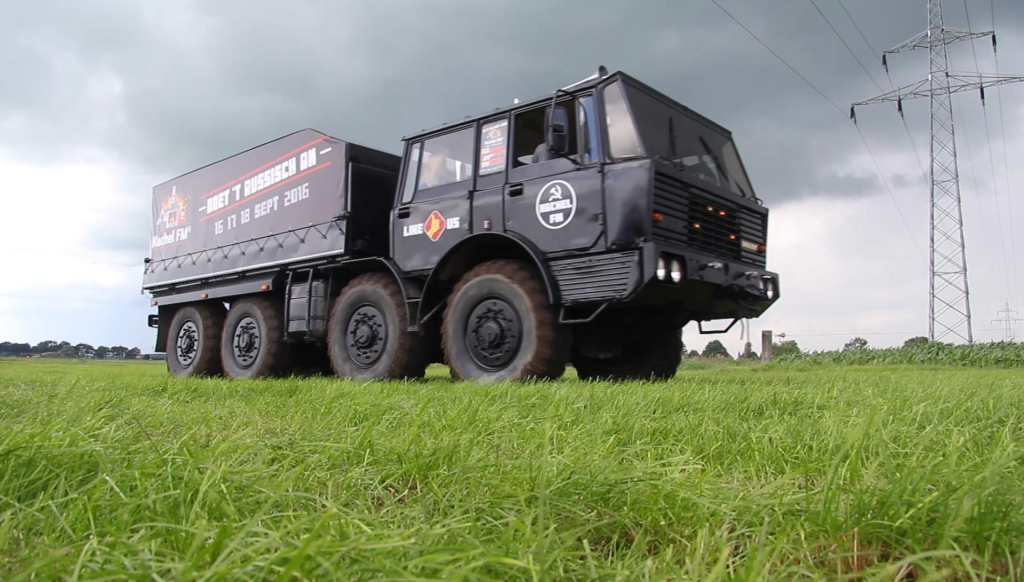 http://www.sallandcentraal.nl/kachel-fm-maakt-zich-met-legertruck-op-voor-feestweekend
http://www.sallandcentraal.nl/kachel-fm-maakt-zich-met-legertruck-op-voor-feestweekend

